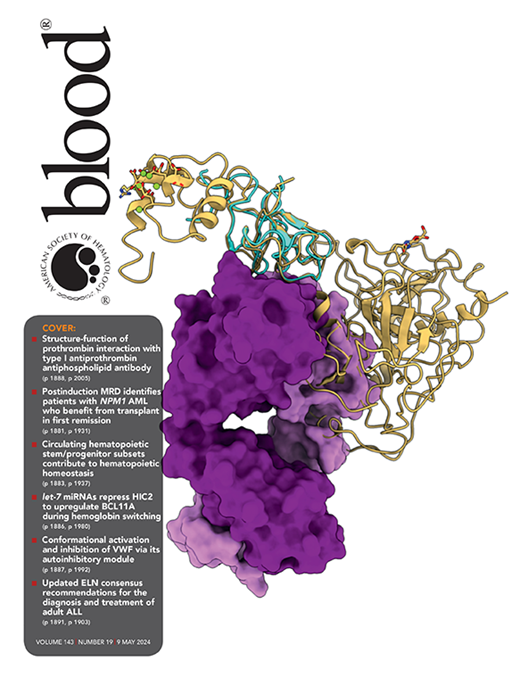In this issue of Blood, Arce and colleagues present an elegant study showing that the autoinhibitory module (AIM) of von Willebrand factor (VWF) may be targeted to either be activated or inhibited.1 The VWF A1 domain contains the binding site for platelet glycoprotein Ib-alpha (GPIb) and this represents the initial port of interaction for circulating platelets and VWF at sites of injury.2 Recent work has demonstrated that the 2 proline and O-linked glycan-rich regions that exist on either side of the VWF A1 domain cooperate to control access of GPIb to its binding site.3-5 These have been termed the N-terminal and C-terminal AIM (N-AIM and C-AIM, respectively).
In their study, Arce et al generated nanobodies against a VWF A1 protein containing both AIM sequences. Next, they selectively sorted the nanobodies to isolate specific binders to the 2 AIM portions. Three nanobodies, 6C4, 6C11, and 6D12, induced platelet activation and binding to GPIb similar to ristocetin, indicating activation of VWF. These 3 nanobodies all bound to the N-AIM with high (nanomolar) affinity and, very interestingly, 6D12 recognized an epitope in the N-AIM that includes the crucial O-linked glycans.6,7 Finally, for this part of the study, the authors used hydrogen-deuterium exchange to demonstrate that 6D12 binds to the N-AIM and increases accessibility of the GPIb binding site. In addition to providing useful information on how the N-AIM functions, these activating nanobodies may well prove to be valuable research tools. Because they behave similarly to ristocetin, these nanobodies may be useful in diagnostic testing for VWF by overcoming some of the pitfalls associated with ristocetin, such as the P1467S mutation that prevents ristocetin binding.8
Arce and colleagues also investigated nanobodies against the C-AIM and identified 2 clones: Nd4 and Nd6. In contrast to the N-AIM nanobodies, Nd4 and Nd6 both inhibited platelet aggregation and, moreover, inhibited VWF-mediated platelet capture under arterial shear stress. The authors then solve the crystal structure of the VWF-A1 domain in complex with Nd6, with some stunning results. The Nd6 clone interacted with the C-AIM regions with some physical distance away from the A1 domain; furthermore, for the first time, the structure was found to resolve one of the O-linked N-acetylgalactosamine residues at position 1468. Most strikingly, it may be first time this structure demonstrated strong evidence of an interaction between N-AIM and C-AIM. From the resolved residues, both AIM modules pointed away from the A1 domain and cooperated to form the entire AIM module that controlled access to the GPIb binding site.
This important study sheds further light on how the VWF A1 domain engages with GPIb and the intricate molecular process that prevents aberrant platelet binding while allowing the VWF molecule to respond to shear forces and promote platelet binding. Although targeting the VWF A1 domain for antithrombotic therapy is not new, understanding how we can selectively target this region without drastic compromise of function may lead to novel and improved anti-VWF targeting agents. This is certainly something to AIM for.
Conflict-of-interest disclosure: The author declares no competing financial interests.

